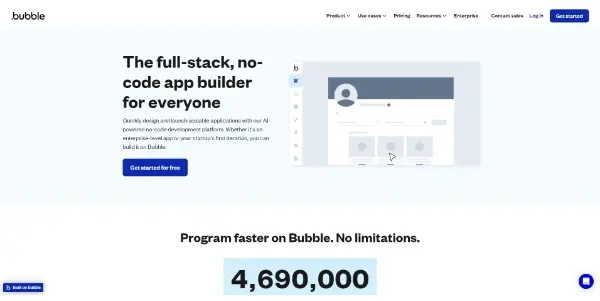Bubble

Create complete web applications without coding. Design your interface visually, define your business logic and rapidly deploy robust applications
Bubble: Building Web Applications Without Code
Bubble is a powerful no-code/low-code platform that empowers users to create complex web applications without writing a single line of code. By visually designing interfaces, defining application logic, and leveraging a robust back-end infrastructure, Bubble enables rapid development and deployment of sophisticated web applications. This article delves into its capabilities, comparing it to similar tools and examining its practical applications.
What Bubble Does
Bubble's core function is to allow users to build fully functional web applications using a visual, drag-and-drop interface. It eliminates the need for traditional coding, allowing individuals with minimal or no programming experience to create dynamic websites and applications. The platform handles the underlying infrastructure, including hosting, databases, and server management, freeing developers to focus on design and functionality.
Main Features and Benefits
Bubble boasts a rich set of features that contribute to its efficiency and versatility:
- Visual Interface Builder: Design the user interface (UI) intuitively using a drag-and-drop interface. Add elements, customize styles, and arrange components with ease.
- Workflow Editor: Define application logic and data flow visually through a workflow editor. This allows you to create complex interactions and automated processes without coding.
- Database Management: Manage data using Bubble's built-in database, creating custom data structures and relationships to suit your application's needs. No SQL experience is required.
- API Integrations: Connect your application to various third-party services and APIs via integrations, expanding its functionality and capabilities.
- Hosting and Deployment: Bubble handles hosting and deployment, ensuring your application is always accessible and reliably performs.
- Version Control: Track changes and revert to previous versions of your application, facilitating iterative development and reducing the risk of errors.
- Extensive Documentation and Community Support: Bubble provides extensive documentation and a thriving community forum, providing ample resources for users to learn and troubleshoot.
Key Benefits:
- Rapid Prototyping: Quickly build and test prototypes to validate ideas before investing significant resources.
- Reduced Development Time and Costs: Significantly reduces development time and associated costs compared to traditional coding methods.
- Increased Accessibility: Empowers individuals without coding skills to build powerful applications.
- Scalability: Bubble's infrastructure scales automatically to handle increasing user traffic and data volume.
- Flexibility: Create diverse applications, from simple landing pages to complex web applications with advanced features.
Use Cases and Applications
Bubble's versatility makes it suitable for a wide range of applications, including:
- E-commerce Platforms: Create online stores with product catalogs, shopping carts, and payment gateways.
- Social Networks: Build custom social networking platforms with user profiles, messaging, and activity feeds.
- Internal Tools: Develop custom applications for internal use, streamlining workflows and improving efficiency.
- SaaS Applications: Create and deploy Software as a Service (SaaS) applications to target specific market needs.
- Marketplaces: Design platforms connecting buyers and sellers in various domains.
- Web Portfolios: Create stunning and interactive online portfolios to showcase your work.
Comparison to Similar Tools
Bubble competes with other no-code/low-code platforms such as Webflow, Softr, and Adalo. While these platforms offer similar visual development capabilities, Bubble distinguishes itself through its powerful workflow engine and its ability to handle complex application logic, making it suitable for significantly more intricate projects than some competitors. Webflow excels in website design, Softr leverages Airtable data, and Adalo focuses on mobile app development. The best choice depends on specific project needs and priorities.
Pricing Information
Bubble operates on a freemium model. A free plan is available for experimentation and small projects, but offers limited features and resources. Paid plans provide increased storage, bandwidth, and access to advanced features, with pricing tiers scaling based on application usage and requirements. Detailed pricing information is available on the Bubble website.
Conclusion
Bubble offers a compelling solution for individuals and businesses seeking to build web applications without coding. Its visual development environment, robust features, and scalable infrastructure make it a valuable tool for rapid prototyping, efficient development, and deployment of sophisticated web applications across diverse use cases. While the learning curve exists, the comprehensive documentation and active community support minimize potential hurdles, empowering users to leverage the platform’s capabilities effectively.